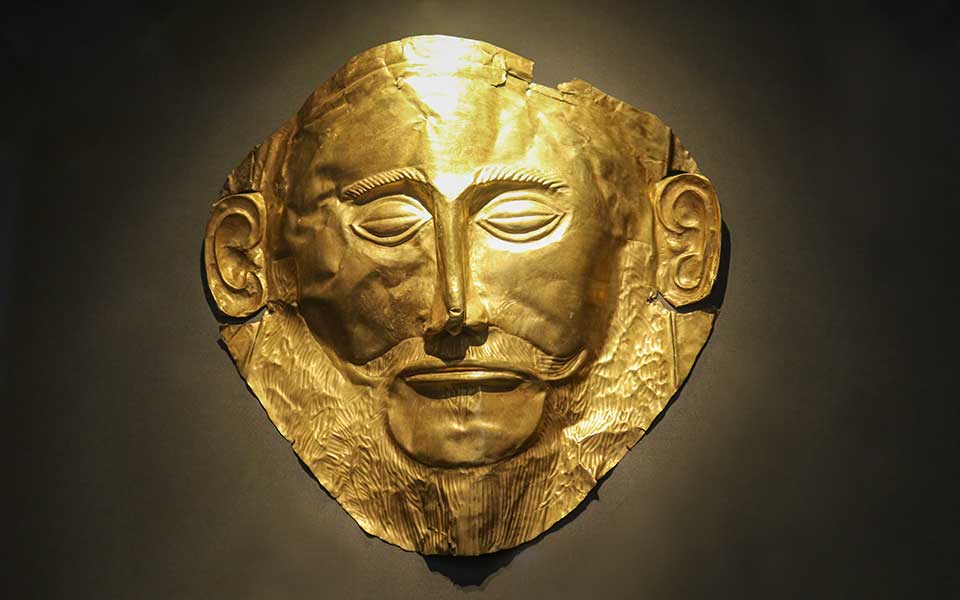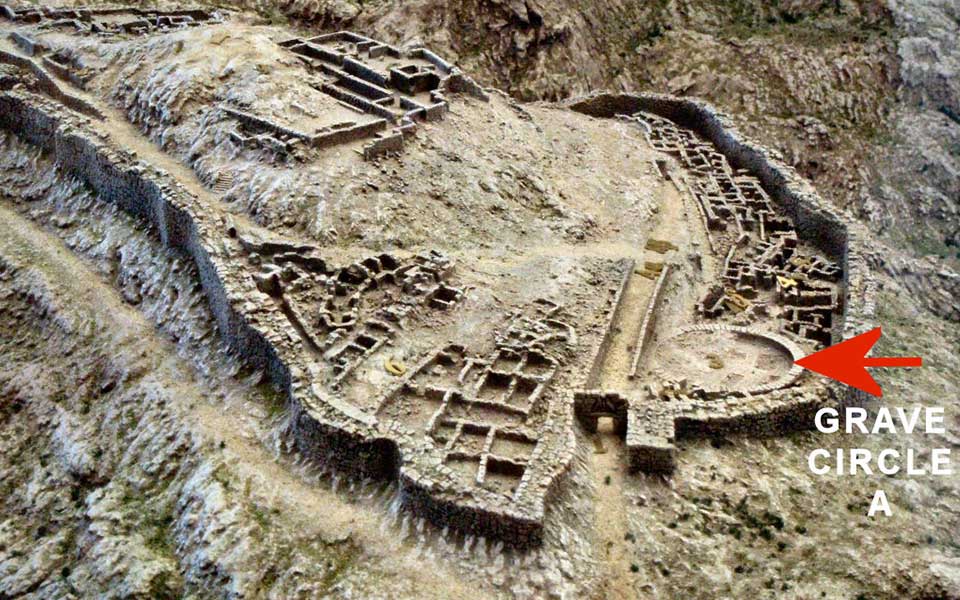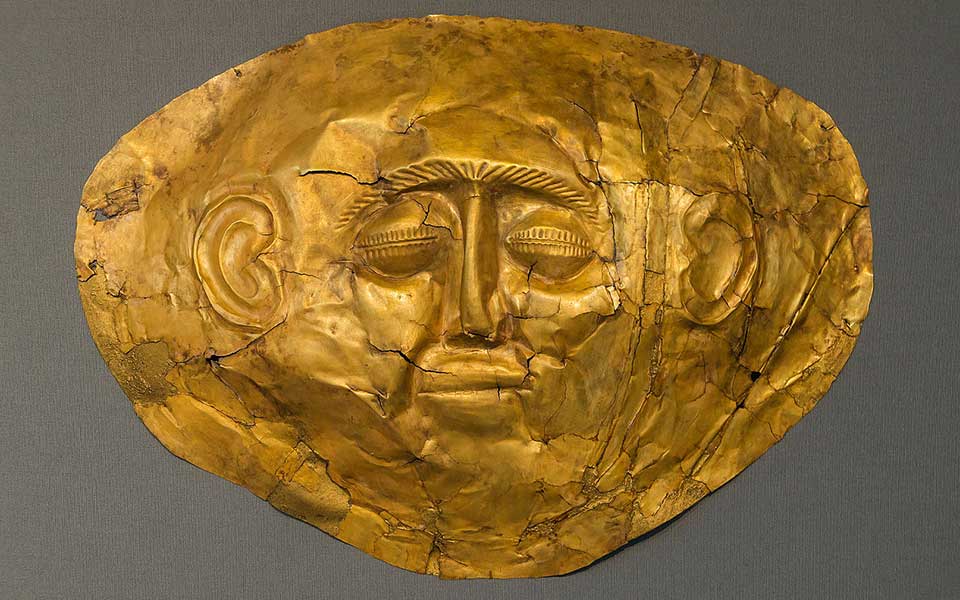Discovering Archaeology in the Athens Metro
Beneath the busy streets of modern...

Gold death mask, famously known as the “Mask of Agamemnon,” found in Grave Circle A at Mycenae. Discovered in 1876 by amateur archaeologist Heinrich Schliemann, the mask is on display in Room 4 of the National Archaeological Museum in Athens.
© Shutterstock
“I have gazed upon the face of Agamemnon,” boasted Heinrich Schliemann, the famous amateur archaeologist who first unearthed the gold funeral mask at Mycenae in 1876.
Imagine his excitement and joy as he carefully brushed away the dirt to reveal the mask, depicting the face of a bearded man, glinting in the sunlight. But did it really belong to the king of Homeric legend?
Schliemann discovered the mask, still fastened to its corpse, in Shaft Grave V of Grave Circle A, immediately south of the Lion Gate, the main entrance of the Bronze Age citadel in the Greek Argolid. It was one of seven death masks discovered in the same grave circle, alongside an enormous cache of gold artifacts, inlcuding ornate weapons, staffs, jewelry, and ceremonial cups.
Ever his own best publicist and exercising a blind faith in the Homeric epics, Schliemann made the extraordinary claim that he had found the remains of Agamemnon, the legendary Mycenaean ruler, in a telegraph to King George of Greece.
Agamemnon’s exploits as the commander-in-chief of the Greek army at Troy were immortalized in Homer’s Iliad. He was murdered upon his return from the war by Aegisthus, the lover of his wife Clytemnestra – the story of the Aeschylus’ tragic play “Agamemnon,” written in the 5th century BC.
Schliemann undoubtedly used the death mask to generate media interest in his excavations at the Bronze Age site, but it’s extremely unlikely that it belonged to the Homeric hero, if indeed Agamemnon ever existed as a historical figure.

Scale model of Mycenae. Grave Circle A is located to the right after the Lion Gate, the main entrance of the Bronze Age citadel.
What we do know is that Schliemann, who retired from commercial activities a multi-millionaire at the age of 36, was a fanatical devotee of Homer, dedicating the rest of his life to proving the historicity of the Iliad and the Odyssey. As such, he gained a reputation for “salting” his archaeological digs with bogus artifacts or objects taken from elsewhere to back up his claims.
His first quest took him to Hissarlik in northwest Turkey, in search of the ancient citadel of Troy. From 1870 to 1873, his excavations, inlcuding the discovery of a large cache of gold artifacts dubbed “Priam’s Treasure,” brought him both international fame and notoriety in equal measure, especially among the academic elite who criticised his heavy-handed methods.
In 1874, Schliemann embarked on excavations at Mycenae, the heavily fortified center that gives its name to the Late Bronze Age culture of mainland Greece from c. 1600 to 1200 BC. The discovery and subsequent publication of the spectacular contents of Grave Circle A, inlcuding the so-called “Mask of Agamemnon,” sparked a global media frenzy at the time, but not everyone was convinced.
Created from a single sheet of gold, heated and hammered against a wooden mold, the mask differs in style from the other death masks of Mycenae, lending support to the theory that Schliemann may have had it manufactured and surreptitiously placed in the shaft grave as part of an elaborate hoax. Proponents of this argument state that it is the only one in three-dimensional form as opposed to flat, with cut-out ears, a finely-detailed beard and handlebar moustache, conspicuously different to how men are depicted in Mycenaean art, and the eyebrows form two arches instead of one. It is also extremely well preserved compared to the others.

One of the other funeral masks from Grave Circle A at Mycenae, also dated to the 16th century BC, but quite different in style to the so-called "Mask of Agamemnon."
So, was it just a publicity stunt? Did Schliemann really fabricate the mask? Or was he simply letting his imagination get the better of him?
Towards the end of this life, Schliemann, accepting doubts about the authenticity of the mask’s true owner, famously conceded: “So this is not Agamemnon … these are not his ornaments? All right, let’s call him Schulze.” But he certainly made no admission of fraud.
Instead, modern archaeological research has tentatively dated the mask to the second half of the 16th century BC, at least 300 years before the Trojan War of Iliad-fame. One study even dated it as far back as 2500 BC – the Early Helladic period of mainland Greece.
The majority of scholars today agree that the gold mask is authentically Mycenaean, an exquisite example of the early repoussé (embossing) technique, and likely belonged to a warrior king or someone of extreme wealth and importance in early Mycenaean culture. Interestingly, death masks like the ones found at Mycenae have not been found at any other site from the Mycenaean world. As such, the mystery surrounding their origins continues.
The iconic “Mask of Agamemnon,” even if it didn’t belong to the Homeric king, is nevertheless an extraordinary treasure of prehistoric Greek archaeology. It can be seen on display in Room 4 of the National Archaeological Museum in Athens, mounted centrally with the other gold masks from Grave Circle A, amid the spectacular Collection of Mycenaean Antiquities.
Beneath the busy streets of modern...
In a land where the past...
From Mycenaean citadels to ancient stadiums,...